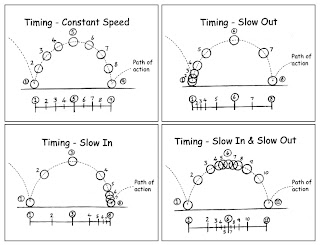Today we got message from Dr Jamal that class for today is cancelled and will be substitute to another time due to he was involved in pre-workshop at our faculty.
We were at the faculty actually when received his sms and we proceed to do our group assignment.
Monday, November 26, 2012
Monday, November 19, 2012
Week 11 : Principles of Animation
Before semester break, Dr Jamal have give us homework about the principles of animation. Dewi, Fadlee and Che Ku was presented their topic in class today. After that, Dr Jamal discussed the principles with details..
There are 12 basic principles of animation introduced by the Disney animators Ollie Johnston and Frank Thomas in their 1981 book The Illusion of Life: Disney Animation.
This principles Squash and Stretch is contracting and expanding movement within a shape as it moves through action. Also squash and stretch is useful in animating dialogue and doing facial expressions.
Appealing animation does not mean just being cute and cuddly. All characters have to have appeal whether they are heroic, villainous, comic or cute. Appeal, as you will use it, includes an easy to read design, clear drawing, and personality development that will capture and involve the audience's interest.
There are 12 basic principles of animation introduced by the Disney animators Ollie Johnston and Frank Thomas in their 1981 book The Illusion of Life: Disney Animation.
- SQUASH AND STRETCH
This principles Squash and Stretch is contracting and expanding movement within a shape as it moves through action. Also squash and stretch is useful in animating dialogue and doing facial expressions.
- SLOW-OUT AND SLOW-IN
- EXAGGERATION
- FOLLOW THROUGH AND OVERLAPPING ACTION
- ANTICIPATION
- the preparation for the action - this is anticipation
- the action
- the termination of the action
- STAGING
- STRAIGHT AHEAD ACTION AND POSE TO POSE
- ARCS
- SECONDARY ACTION
- TIMING
- SOLID DRAWING
- APPEAL
Appealing animation does not mean just being cute and cuddly. All characters have to have appeal whether they are heroic, villainous, comic or cute. Appeal, as you will use it, includes an easy to read design, clear drawing, and personality development that will capture and involve the audience's interest.
.gif) |
| "My mum told me never to forget my principles" |
Monday, November 12, 2012
Week 10 : Mid Term Break
During mid term break, we have homework to do. We need to choose 1 of 12 topic for Animation Principles from utm e-learning. My topic is "Staging".
There are my presentation slides that i have been prepared for presentation.
There are my presentation slides that i have been prepared for presentation.
Monday, November 5, 2012
Week 9 : Animation Terms
Today is the starting of our second part in this subject which is called "Animation". This part will be lecture by Assoc Prof Dr Jamaludin Harun.
For the introduction, Dr Jamal was told us to flash back how to make an animation using Adobe Flash software. He also remind us that he not going to teach from basic because all of us should be have some experience in this software during our Authoring System class.
For flash back our knowledge in Adobe Flash, Dr give us several terms which is used before.
For the introduction, Dr Jamal was told us to flash back how to make an animation using Adobe Flash software. He also remind us that he not going to teach from basic because all of us should be have some experience in this software during our Authoring System class.
For flash back our knowledge in Adobe Flash, Dr give us several terms which is used before.
- Keyframes - allowed to insert an instance
- Tweening - in between of key frames.
- Onion Skinning - creating animated and editing movies to see several frames at once
- Frame by frame - showing a series of frames
- Frame rate - number of frames per second (fps). For computer animation just enough to use 12 - 15 frames per second.
| Onion skinning animation |
Subscribe to:
Comments (Atom)









